I was delighted when I found these May Flower pattern of Vernon Kilns Plates Vernonware, Bread and butter plates with Copeland Spode Cups from the 1940’s. There’s something really special about dishes that have stood the test of time. It’s hard to believe that a dish could still be this colorful at almost 80 years old.
An embossed rope-like border goes around the edge of each eggshell-colored piece. The floral design is reminiscent of bouquets I’ve gathered as I’ve walked down old dirt roads in the hills barefooted. Every now and then you might spot a rose bush that was probably planted years ago when a house stood nearby. I can picture in my mind a clothesline that would have been filled with pants and shirts, all washed the hard way. And while I’m imagining, I can see the family dog chasing the kids. It’s hard to imagine how different times were when the family ate off these dishes in the World War II era of the 1940’s.
I love plate stacking.
As much as I love to see the beautiful edge of a second plate framing a top plate, I just couldn’t cover these delightful mountain blooms on these Vernon Kilns plates. It covered way too much of the delightful pattern, which is described on the back as “hand painted under glaze”. Placing the bread-and-butter plates on the table expanded the lovely visual.
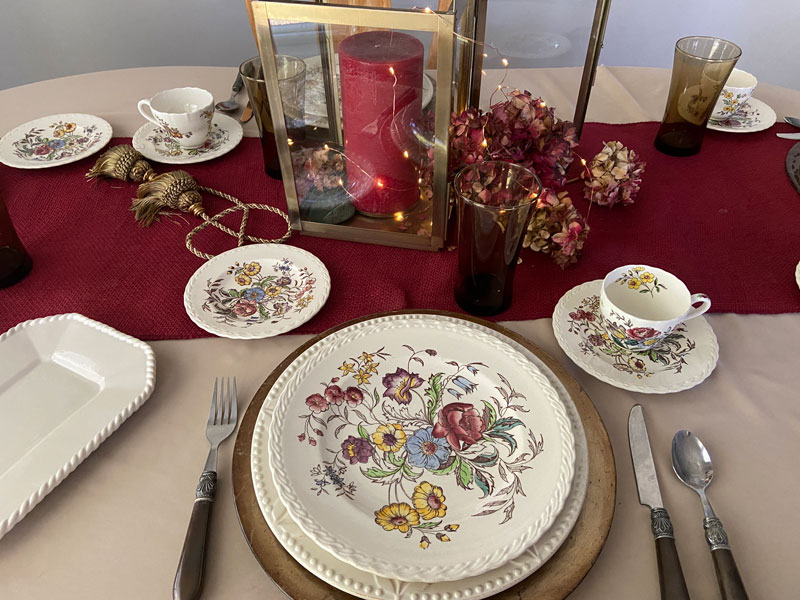
Vernon Kilns Plates, but the cups are what?
When I began sanitizing my beautiful stack of dishes, I discovered that the cups are not Vernon Kilns May Flower. Instead, the cups, every single one of them were manufactured by Spode and manufactured in England. The bottom of the cup says 5245 Copeland SPODE, Great Britain Gainsborough with a tiny green mark. Everything else except the cups and a single saucer wore the Vernon Kilns May Flower brand. One and only one saucer worn the SPODE logo.
The lady that put this set together did something else that surprised me, she used the bread-and-butter plates for saucers. They are actually 1/2 inch wider that the actual cup saucers.
I love what she did.
I’m not sure why she mixed the pieces from two manufacturers, but I love the result! I would love to fill two of these cups with hot coffee and get to share it with the lady that purchased this set of dishes. I would sit her cup in the only SPODE saucer, then I would ask her, “What were you thinking?
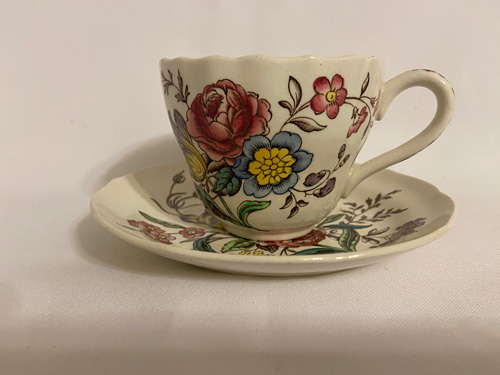
Did you prefer the Spode dishes from England, but only have enough money for Vernon Kilns May Flower? Did the war limit the availability of cups, so that was all that was available? Were you like me and thought the Spode cups were more beautiful? I don’t know what she was thinking, but I sure like her taste in dishes. .
The design on the Vernon Kilns plates is close, but different.
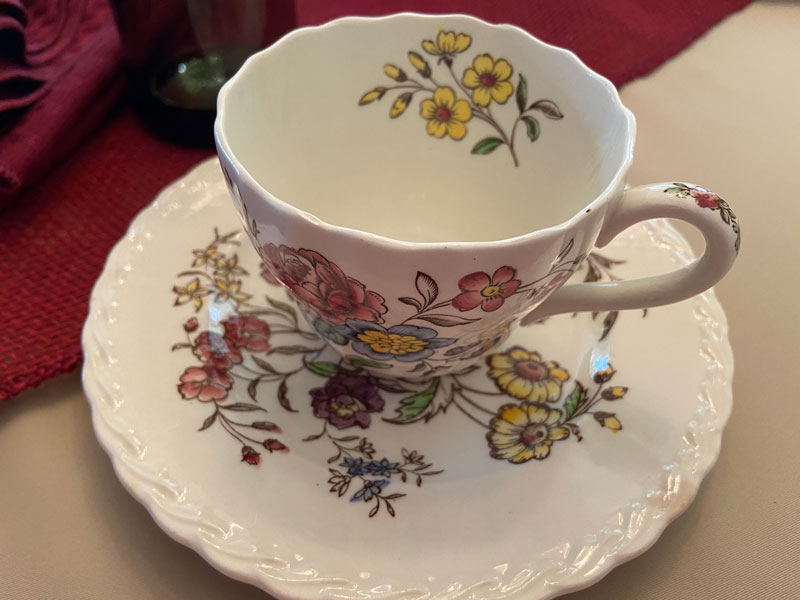


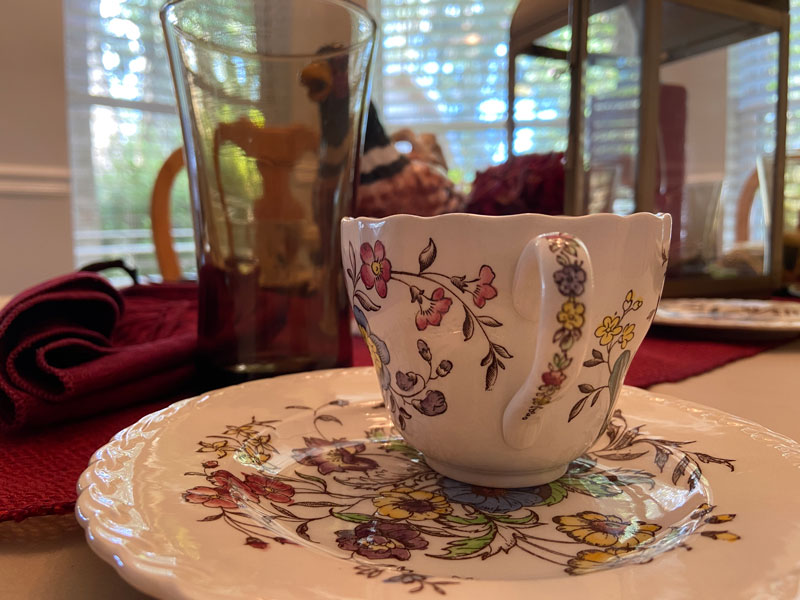
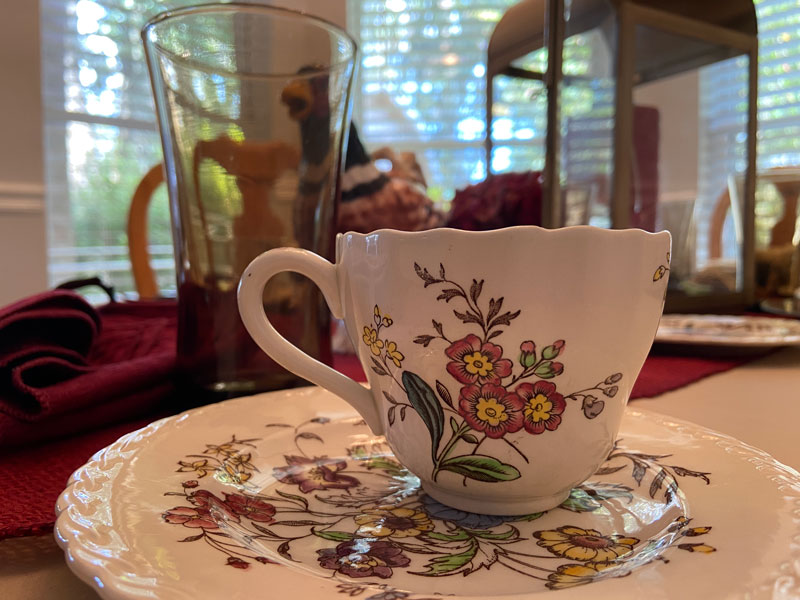
Compare the design to the dinner plate. Placing the cup in front of you with the handle on the right you can view the full bouquet of flowers that look very similar to the May Flower manufactured by Vernon Kilns. When you turn it to face you, you will see the yellow bouquet. Then you see the last bouquet of cranberry flowers with yellow centers. But don’t stop there, look at the cup handle while it is very different from the handle on Vernon Kilns May Flower, the row of flowers decreases in size as they travel down the face of the handle. The edge of the cup has a delicate scallop. But the thing that made me fall in love with these cups is the yellow flower that peers out at me from inside the cup. I love, love, love it when the inside of the cup is decorated also. Was she thinking? “I love these cups!”
Sometimes, I ask myself, “Pat, what were you thinking?”
Most of the time my answer is, “I wasn’t thinking!” Not thinking things through gets me in trouble. When I don’t stop and think about things, I make blunders. Those blunders encourage me to think things through more carefully.
One of those blunders, is not being thankful.
I realize that most of the time, I stack blessings all together like I stack a set of dishes and mindlessly shove them onto a shelf until next time. I offer up a quick “I am so blessed” or “Thank you for blessing me, Father.” So often my quick thank you is done without engaging my heart.

A Quick “Thank You” is Good.
Yet, we can dive deeper into gratitude. Instead of stacking the blessings and giving a general thank you, begin to make gratitude a way of life.
Single out a single blessing and give thanks for it. When you begin to be thankful for something, you will see it differently, because you have given it greater value by giving thanks for it. I believe you will even enjoy it more. Giving thanks develops an attitude of gratitude. I have learned that gratitude is one of the most valuable gifts anyone can ever have–and you have to give it to yourself!!!
Gratitude puts value on the giver and the gift.
So…let me challenge you.
In your journey to enjoy life more, become more think-full.
Instead of thinking about everything you don’t have.
Think about what you do have and give God thanks for your blessing…yes, name a single blessing. Think-full and become thankful.
Psalm 118:1 ESV Oh give thanks to the LORD, for he is good; for his steadfast love endures forever!
You’ll enjoy everything you have more when you give thanks to the Lord.
I hope that this week you will add some happy to your table and some joy to your heart.
Would you like more inspiration? I’ll put a link to my blog where my granddaughter taught me to open my eyes are see the beauty in my neighbor. Carry Your Camera
This beautiful table setting is available for sale. Click here for details.
Complete Table Setting

